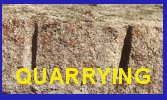



 |
 |
 |
 |
|
|
|
|
|
|
|
Revised Dating for Plug & Feather Method and Flat Wedge Method By James Gage & Mary Gage © 2015 At a Glance Flat Wedge Method – Developed in the late 1790s in the Danvers/Lynnfield area of Massachusetts, introduced into the Quincy quarries in 1803, and rapidly spread from there. Earliest dated example is 1800. Commercial Plug & Feather Method – New dating 1818 to present. Earliest dated examples are from 1818 (MA) and 1823 (CT, MA, & NH) Detailed Discussion Researchers have relied upon Shaw’s 1859 speech (see page 36 in “The Art of Splitting Stone”) for the early history of the commercial plug & feather method and particularly dating its introduction into the Quincy quarries to circa 1803. Over the years questions have occasionally been raised over the reliability of this source. The lack of pre-1823 examples of the plug & feather method has been very puzzling. New research in the past two years has shed new light on the details of the Shaw speech. Shaw retold in detail the story given to him by Lt. Governor Robbins. Robbins was directly involved in the efforts to build a new state prison in Charlestown, MA. In 1803, Robbins discovered a new more efficient and cost effective method of splitting stone while traveling through Salem, MA. Up to that point, splitting stones into blocks suitable for buildings had been a slow, labor intensive and costly process. The split stone Robbins saw in the foundation was supplied by a Mr. Galusha who purchased it from a stone splitter named Mr. Tarbox. Robbins talked with Tarbox who explained how the splitting method worked. (Tarbox made no claims he invented it). Recognizing the importance of the method, Robbins paid Tarbox to travel to the Quincy quarries and to train their quarrymen how to use his splitting method. Shaw states the quarry marks were “six to seven inches apart” and that Mr. Tarbox explained to Robbins “his mode of drilling the holes, and inserting and driving the small wedges …” The long standing assumption has been that this description was a reference to the commercial plug & feather method. This assumption has been based upon the 6-7 inch distance between the quarry marks and the verb “drilling.” By modern standards, the term “drilling” refers to boring a round hole. In 1800s, the word had a broader range of meaning especially in the quarry industry. There is a single published description of a second widely used 1800s stone splitting method: the flat wedge method. In 1833, Prof. Edward Hitchcock wrote: “The manner in which the granite is usually split out of the quarries is this. A number of holes, of a quadrangular form, a little more than an inch wide, and two or three inches deep, are drilled into the rock, at intervals of a few inches, in the direction in which it is wished to separate the mass. Iron wedges, having cases of sheet iron, are then driven at the same time, and with equal force, into those cavities; and so prodigious is the power thus exerted, that masses of ten, twenty, thirty, and even fifty and sixty feet long, and sometimes half as many wide, are separated. These may be subdivided in any direction desired; and it is common to see masses thus split, till their sides are less than a foot wide, and their length from ten to twenty feet. In this state they are often employed as posts for fences.” (Hitchcock 1833, 127) The trapezoid shaped holes of the flat wedge method (see illustration on page 43 of “The Art of Splitting Stone”) which were cut or chiseled out by a cape chisel are described in this account as having been “drilled.” The term “drilled” or “drilling” was used for both the round holes of the plug and feather method & trapezoid shape holes of the flat wedge method. When Robbins told the story to Shaw he could have been describing either method. Which one was Robbins referring to? The answer to this question comes from an unlikely source. The congregation of the Unitarian Church in Newburyport decided to build a new meeting house (church). The foundation for the new meeting house was completed in the fall of 1800. Below ground the foundation was made of field stones laid in mortar. The exterior of the above ground part of foundation was built with quarried stone bars which had been hammered to a smooth surface. The granite bars were quarried with the flat wedge method. The account for the construction of the Unitarian Church has survived. It lists a payment for “October 8 [1800] – J. Galusia’s bill Stones [$]289.16”. (Gage & Gage 2013) “J. Galusia” was Jacob Galeucia of Salem, MA. (There are numerous spellings of his last name.) He is listed in period records as a “stone cutter,” a term used to describe a tradesman who by using various hammers and chisels created a finished surface on rough quarried stone suitable for the exterior of buildings. Most stone cutters were also stone dealers, and that is the case with Galeucia. Jacob Galeucia was the “Galusha” that supplied the stone for the foundation that Robbins saw. We know from the Unitarian Church foundation stones that Galeucia was selling stone split with the flat wedge method. Tarbox trained the Quincy quarrymen on how to use his method in 1803. Historian William Pattee, in his book “History of Old Braintree and Quincy” recorded the first experimental use of the flat wedge method in Quincy in the same year: 1803. Although Pattee failed to mentioned Robbins or Tarbox in his account of the experiment, it is clear the two stories are interrelated and were part of the same chain of events. There is one anomaly in Shaw’s retelling of Robbins story. Shaw described the holes as 6 to 7 inches part which is the typical spacing for the plug and feather method. The flat wedge method spaced the holes every 3 to 4 inches apart. By the late 1850’s when Shaw gave his speech, the commercial quarry industry was dominated by the plug & feather method. (The flat wedge method continued to be used at some small local quarries). Shaw either misremembered this detail or forgot it and filled this “fact” in based upon his familiarity with the plug & feather method which was in wide spread usage at the time. Commercial Plug & Feather Method After the release of this update in July 2015 (which listed the oldest dated examples of the commercial plug & feather method as 1823), an earlier example was discovered on the below grade portion of the granite foundation of the Salem Custom House (Massachusetts). Ground was broke in August 1818 for the new building. (Carroll 1977, 12-13) It is likely the granite foundation was laid in the fall of 1818. The building was completed by June 1819. A single exposed block of the below granite foundation had 4 half round drill marks (3/4 inch dia., 2 inch deep, and spaced from 7 to 4 ¼ inches apart). The stone may have been quarried from boulders and ledges in Danvers. This is the earliest firmly dated example of commercial plug and feather method. There is an 1815 stone mill building in Glocester, RI which has a window lintel stone that appears to be a transitional form between the 1790s farmers version of the method and the commercial version. (The major difference between the two versions is the farmers’ version used only 2 to 3 holes to split a boulder regardless of its length, whereas the commercial version spaced the drilled holes every 6-7 inches which was far more effective.) The pre-1818 history of the commercial version is a mystery. It is safe to state that the commercial version was developed after the 1803 introduction of the flat wedge method into the Quincy quarries and prior to 1818. For dating purposes, the plug and feather quarry marks date (conservatively) from 1818 or later (rather than 1803 as stated in 2nd edition of “The Art of Splitting Stone”).
1818 Salem, MA – Fall of 1818, quarried granite foundation of Salem Custom House was laid. Building was finished in June 1819.
1823 Newmarket, NH – Newmarket Manufacturing Mill Buildings #1 & #2 1823 Eastford, CT – Phoenixville Mill (no longer standing – destroyed by fire) 1823-24 Quincy, MA - First Parish Church 1823-25 Perimeter wall of Charlestown Navy Yard made from Quincy granite 1826 Quincy, MA – Granite Railway Note: The authors are interested in any examples of the plug & feather method found on buildings or structures dated to 1825 or earlier. Please contact us at the email address below. References Carroll, Orville W. 1977 Historic Structure Report: The Custom House-Bonded Warehouse. Boston, MA: North Atlantic Preservation Center. Gage, Mary & James Gage 2013 “First Religious Society Unitarian Church, 26 Pleasant Street, Newburyport, MA: Report on Quarried Stones in Foundation Built in 1800.” Revision 12/8/2013 Hitchcock, Edward 1833 Report on the Geology, Mineralogy, Botany, and Zoology of Massachusetts. Amherst [MA]: Press of J.S. and C. Adams. |
|
|
|||||||||
 |
|||||||||
|
|
|||||||||
 |
|||||||||